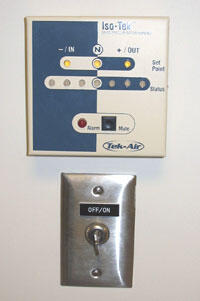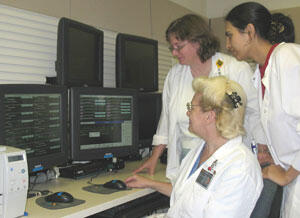July 19, 2004
North Hospital's renovated 9th floor is VCU Medical Center's most versatile patient ward
Share this story

The 9th floor of VCU Medical Center's North Hospital has been transformed into the most versatile ward for patient care following more than a year of construction.
North 9 is now home to the Intermediate Care/Telemetry Unit, which provides care to patients who often require special monitoring after leaving an intensive care unit. It also
is equipped with so-called negative-pressure rooms to treat patients with airborne infections, and if necessary, can also be used as a temporary intensive care unit.
Sleek black antennas hanging from hallway ceiling tiles relay a patient's heart rate 24 hours a day to a specially equipped, remote monitoring room near the nurses' station. Patients are outfitted with portable transmitters, about the size of a deck of cards. Monitor technicians maintain an electronic vigil on all 30 of the patients that may be accommodated on this floor. The system has additional capacity and already monitors Acute Care Medicine patients on North 5. Plans call for adding more North Hospital units in the future.
"Many of our patients have been diagnosed as at risk for a cardiac event that would adversely affect their health, so we want to keep an eye on them," said Sue Harrison, R.N., manager of intermediate care/telemetry. "The telemetry monitor can also assist with a more-complicated diagnosis since we can see exact heart rhythm changes or changes that occur under stress or physical activity."
The telemetry infrastructure is only part of the technology story for North 9. The newly renovated unit is also the largest negative-pressure ward at VCU Medical Center, making it the area best suited to accommodate patients with airborne infections like influenza, tuberculosis and SARS.

"It is a versatile unit," said Michael B. Edmond, M.D., VCU Medical Center epidemiologist. "We can use it as a regular ward or change some of the rooms to negative pressure to treat patients with TB or other communicable diseases. Or we can make all the rooms negative pressure if we have an outbreak of a communicable disease like SARS."
In a room configured for negative pressure, the ventilation system prevents air in the patient room from moving into the hallway, protecting other patients, visitors and healthcare workers from airborne viruses and bacteria. The rooms on North 9, both private and semi-private, have independent, key-operated switches that activate the negative-pressure ventilation for each room.
Before the new North 9 opened, VCU Medical Center already had 18 negative-pressure rooms located among and across several floors and medical services. None of those rooms was taken out of service, more than doubling negative-pressure bed capacity.
Intermediate Medicine/Telemetry was moved to the North Hospital from the Main Hospital's 8th floor, putting it closer to acute care medicine to streamline travel time between care areas. If necessary, the ward could be converted into a temporary intensive care unit, providing three-way flexibility.
Subscribe to VCU News
Subscribe to VCU News at newsletter.vcu.edu and receive a selection of stories, videos, photos, news clips and event listings in your inbox.




